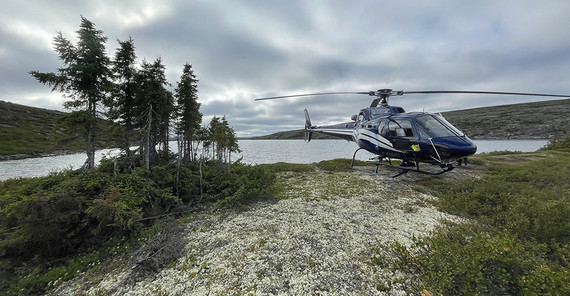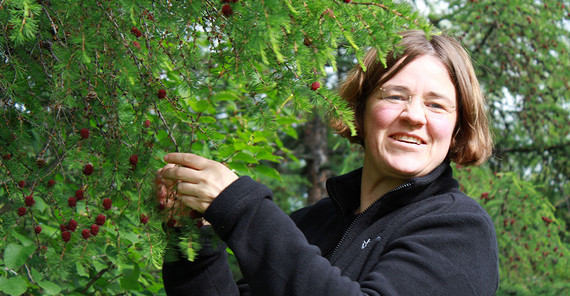The interest of terrestrial paleoecology at the AWI is directed precisely at such transitions from cold to warm periods, also in order to be able to predict possible consequences of current climate change. Herzschuh and her team use cores from sediments of Arctic lakes, from which they can read the vegetation history of tens of thousands of years.
“The nature of the Arctic is little influenced by humans and therefore particularly suitable for studying fundamental processes,” explains Herzschuh, who holds a professorship in Statistical and Dynamical Integration of Paleoenvironmental Data at the University of Potsdam.
She herself lends a hand with the drilling on site. No easy job, as her colleague Kathleen Stoof-Leichsenring confirms. Far from civilization, they are dropped into the tundra by helicopter, set up camp, and build floating platforms from which they drill up to 15 meters deep into the lake bed. What they unearth in plastic tubes is packed in boxes and sent to Potsdam. Often weeks, sometimes months later, the precious cargo arrives at Telegrafenberg. There, Stoof-Leichsenring has swapped her mosquito-repellent shirt for full protective overalls to analyze the samples in the ultra-clean laboratory. “Whereas just a few years ago we only extracted pollen and fossil residues to reconstruct the vegetation of past times, we are now taking a decisive step forward,” says Stoof-Leichsenring, a molecular biologist who studied and earned her doctorate at the University of Potsdam and now teaches a course on “Terrestrial Paleoecology.” At the Alfred Wegener Institute, she heads the state-of-the-art paleogenetics lab, where ancient DNA is extracted from musty lake sediments and enriched for sequencing. “They are often just short fragments of DNA from species that washed into the lake – plant, animal and bacterial. But they can be used to recognize entire ecosystems,” she reports. “This enables us to look back in time to the late Pleistocene, 50,000 to 30,000 years ago.”
Herzschuh describes the new analytical methods as a revolution: “And we’re only at the beginning; suddenly, whole new worlds are opening up.” Referring to paleoecology, she says, “Something is just exploding.” The insights that are now possible, she says, will become “hugely important” for management decisions in environmental protection. “When did individual species live and in what places? Where did they migrate? This can be studied for animals just as much as for plants,” the professor says, recounting research on the southeastern Tibetan Plateau, one of the most biodiverse mountain regions in the world. To understand how biodiversity changed there after the last ice age, the retreat of the glacier and the return of the forest, Herzschuh and her team studied the sediment of a mountain lake in which sand, dust and plant remains had been deposited for more than 17,000 years. Using the extracted genetic material, they were able to determine which plants had lived at which times. In combination with geological models of the glacier’s movement, they were even able to determine how the plant community changed with the glacier’s elevation and shifting tree line.
They found that during a warm phase around 8,000 years ago, when the forest had migrated higher than today, the number of species in the sediment decreased significantly. In other words, there was a decline in biodiversity. This finding can help to estimate how the biodiversity of alpine mountain regions will be reduced with current climate change.
Herzschuh has also been studying advancing scrub vegetation and shifting timberline in high latitudes, especially in northern Siberia. “Whenever it gets warmer, the forests grow. However, they are extremely slow, and so the bushes are making inroads. What follows is a significant decline in species,” Herzschuh says. This is how it was 9,000 years ago. And it’s happening again now. “For Siberia, however, we can say that the loss of species was significantly lower then than it is today,” Herzschuh sums up in a plea for the tundra to be placed under special protection. More large mammals could also be reintroduced to the region, for example musk oxen and reindeer. They increase biodiversity and structure the landscapes, just like the yaks on the plateaus of Tibet. Ultimately, it comes down to creating “refuges for the survival of species” in these regions.
This text appeared (in german language) in the university magazinePortal - Zwei 2022 „Artensterben“(PDF).



